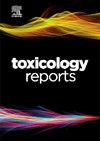慢性肺组织沉积吸入聚乙烯微塑料可导致纤维化病变
Q1 Environmental Science
引用次数: 0
摘要
考虑到空气中微塑料暴露的预期增加,我们在此旨在评估吸入聚乙烯微塑料(PE-MPs)的急性和亚慢性毒性。暴露后24 h(0、125、250和500 μg/肺),pe - mp处理小鼠肺的肺泡巨噬细胞中发现PE-MPs,肺细胞总数增加,肺中LDH、CXCL-1和CCL-2水平升高。同样,当连续14天暴露两次(每周,0、125、250和500 μg/lung)时,暴露于PE-MPs的小鼠肺细胞的总数、肺趋化因子和血液IgE水平升高,而与细胞间相互作用相关的表面蛋白的表达则受到抑制。经气管内反复滴注(0、5、25和50 μg/肺)90天后,PE-MPs沉积在肺组织中,肺细胞总数和炎症细胞因子水平均呈剂量依赖性增加。此外,pe - mp处理的雄性和雌性小鼠肺组织中炎症细胞浸润,多核巨细胞形成,肺泡壁增厚。虽然暴露于PE-MPs后,雄性和雌性小鼠的IgA和IgG的产生受到抑制,但IgE和IgM的水平有增加的趋势。此外,pe - mp处理小鼠肺组织中纤维状胶原的表达增强。综上所述,我们认为慢性肺暴露于PE-MPs可能通过损害肺泡巨噬细胞的抗原呈递功能而导致免疫失调,pe - mp诱导的慢性炎症可能与纤维化病变有关。此外,我们相信这些假设将通过进一步研究慢性暴露于PE-MPs对肺功能的影响来澄清。本文章由计算机程序翻译,如有差异,请以英文原文为准。
Chronic lung tissue deposition of inhaled polyethylene microplastics may lead to fibrotic lesions
Given the expected increase in exposure to airborne microplastics, we here aimed to assess the acute and subchronic toxicity of inhaled polyethylene microplastics (PE-MPs). At 24 h post-exposure (0, 125, 250, and 500 μg/lung), PE-MPs were found within alveolar macrophages in the lungs of PE-MP-treated mice, along with an increase in the total number of pulmonary cells and higher pulmonary levels of LDH, CXCL-1, and CCL-2. Similarly, when exposed twice for 14 days (weekly, 0, 125, 250, and 500 μg/lung), the total number of pulmonary cells and the levels of pulmonary chemokines and blood IgE were elevated, whereas the expression of surface proteins related to cell-to-cell interactions was inhibited on the pulmonary cells of mice exposed to PE-MPs. After 90 days of repeated intratracheal instillation (0, 5, 25, and 50 μg/lung), PE-MPs deposited in the lung tissues and increased dose-dependently both the total number of pulmonary cells and inflammatory cytokine levels. Furthermore, infiltration of inflammatory cells, formation of multinucleated giant cells, and thickening of the alveolar wall were noted in the lung tissues of PE-MP-treated male and female mice. While the production of IgA and IgG was inhibited in male and female mice following exposure to PE-MPs, the levels of IgE and IgM tended to increase. In addition, the expression of fibrillar collagens was enhanced in the lung tissues of PE-MP-treated mice. Taken together, we suggest that chronic pulmonary exposure to PE-MPs may cause immune dysregulation by impairing the antigen-presenting function of alveolar macrophages and that PE-MP-induced chronic inflammation may be linked to fibrotic lesions. In addition, we believe that these hypotheses will be clarified by further study of the effects of chronic exposure to PE-MPs on lung function.
求助全文
通过发布文献求助,成功后即可免费获取论文全文。
去求助
来源期刊

Toxicology Reports
Environmental Science-Health, Toxicology and Mutagenesis
CiteScore
7.60
自引率
0.00%
发文量
228
审稿时长
11 weeks
 求助内容:
求助内容: 应助结果提醒方式:
应助结果提醒方式:


